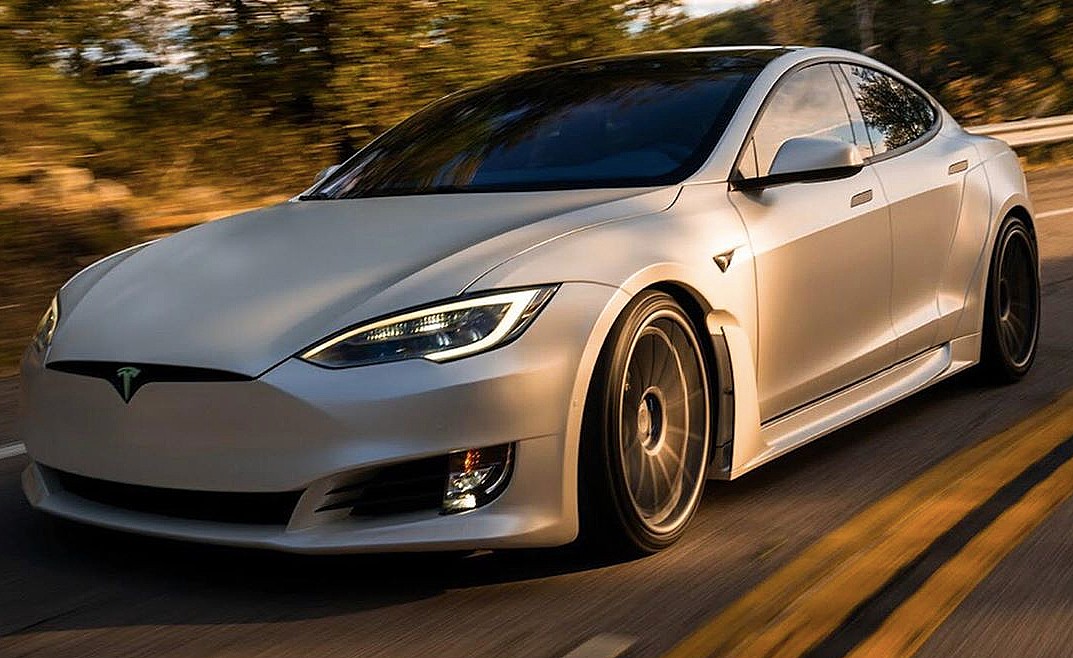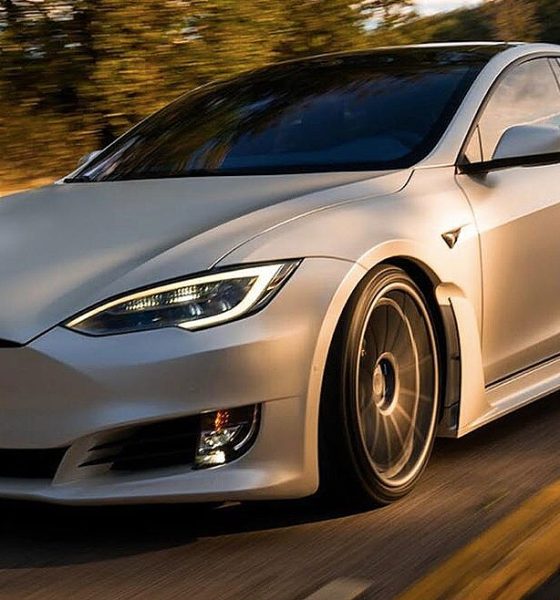

News
Tesla adds “Cheetah Stance” Launch Mode for acceleration boost
Just a few days ago, Tesla updated its online configurator for the Raven Model S and Model X Performance to reflect the flagship vehicles’ improved acceleration figures. While already blazingly-quick, the Raven Model S Performance’s 0-60 mph time was reduced to 2.3 seconds, while the Raven Model X was improved to just 2.6 seconds.
It appears that existing owners of the Raven Model S and Model X Performance are set to receive the acceleration boost update as well. A recent post from Tesla owner and noted YouTube tech reviewer Marques Brownlee revealed that faster acceleration is not all that Model S owners will be receiving. More endurance for back to back full power launches are also included in the over-the-air update, on top of the vehicle’s new “Cheetah Stance” Launch Mode.
Rule #1 is never buy a product based on promised software updates but wow I'll take it. Thanks @Tesla 🤓 pic.twitter.com/QXKvB0Qaen
— Marques Brownlee (@MKBHD) April 23, 2020
Just like other updates such as Sentry Mode, the acceleration and endurance boost to the Raven Model S and Model X Performance is a free upgrade. As per tests by veteran drag racer and longtime Tesla owner Brooks Weisblat, the Cheetah Stance Launch Mode update adds about 46 horsepower to the Model S. Such an upgrade is no joke, and the fact that it’s free makes it even better.
Following is Tesla’s message about the new Model S Performance’s acceleration and endurance boost.
Update available—Your Model S Performance just got quicker
You asked for it. With our latest over-the-air software update to Model S Performance, we improved 0-60 acceleration to 2.3 seconds and quarter-mile time to 10.4 seconds. Go for more back-to-back runs with improved thermal endurance, and activate Launch Mode with a press of the pedals. Launch Mode’s new Cheetah Stance lowers the front axle and adjusts damping before entry for better traction and faster acceleration off the line.
You’ll automatically receive this update based on your location and vehicle configuration—you can’t request the update. Connect to Wi-Fi or a mobile hotspot to download and install quicker.
Bro the performance update happened to my pre raven p100d via over the air update. 0-60 in 2.6 seconds. pic.twitter.com/h801SK2L6v
— Tesla Owners Silicon Valley (@teslaownersSV) April 23, 2020
With this recent update, the Raven Model S can now give the Porsche Taycan Turbo S an even more intense battle in the quarter mile. Few legitimate drag races between the two high-performance electric cars have been done to date, though the Taycan has an advantage in higher speeds due to its two-speed gearbox. With its recent Cheetah Stance update and acceleration boost, the Raven Tesla Model S Performance becomes a much more formidable vehicle in the quarter mile. The same goes for the Model X Performance.
What’s even more exciting is the fact that these improvements are just being rolled out to the Raven Model S and Model X Performance. Tesla has an even more formidable flagship vehicles in store in the form of the Plaid Model S and X. That vehicles will be frighteningly fast, with the Plaid Model S’ track capabilities are honed in the Nurburgring. Granted, the Plaid Model S will cost more compared to the Raven Model S Performance, but it will likely still undercut rivals such as the Taycan Turbo S, which starts at about $180,000 before options.

News
Tesla starts showing how FSD will change lives in Europe
Local officials tested the system on narrow country roads and were impressed by FSD’s smooth, human-like driving, with some calling the service a game-changer for everyday life in areas that are far from urban centers.

Tesla has launched Europe’s first public shuttle service using Full Self-Driving (Supervised) in the rural Eifelkreis Bitburg-Prüm region of Germany, demonstrating how the technology can restore independence and mobility for people who struggle with limited transport options.
Local officials tested the system on narrow country roads and were impressed by FSD’s smooth, human-like driving, with some calling the service a game-changer for everyday life in areas that are far from urban centers.
Officials see real impact on rural residents
Arzfeld Mayor Johannes Kuhl and District Administrator Andreas Kruppert personally tested the Tesla shuttle service. This allowed them to see just how well FSD navigated winding lanes and rural roads confidently. Kruppert said, “Autonomous driving sounds like science fiction to many, but we simply see here that it works totally well in rural regions too.” Kuhl, for his part, also noted that FSD “feels like a very experienced driver.”
The pilot complements the area’s “Citizen Bus” program, which provides on-demand rides for elderly residents who can no longer drive themselves. Tesla Europe shared a video of a demonstration of the service, highlighting how FSD gives people their freedom back, even in places where public transport is not as prevalent.
What the Ministry for Economic Affairs and Transport says
Rhineland-Palatinate’s Minister Daniela Schmitt supported the project, praising the collaboration that made this “first of its kind in Europe” possible. As per the ministry, the rural rollout for the service shows FSD’s potential beyond major cities, and it delivers tangible benefits like grocery runs, doctor visits, and social connections for isolated residents.
“Reliable and flexible mobility is especially vital in rural areas. With the launch of a shuttle service using self-driving vehicles (FSD supervised) by Tesla in the Eifelkreis Bitburg-Prüm, an innovative pilot project is now getting underway that complements local community bus services. It is the first project of its kind in Europe.
“The result is a real gain for rural mobility: greater accessibility, more flexibility and tangible benefits for everyday life. A strong signal for innovation, cooperation and future-oriented mobility beyond urban centers,” the ministry wrote in a LinkedIn post.
News
Tesla China quietly posts Robotaxi-related job listing
Tesla China is currently seeking a Low Voltage Electrical Engineer to work on circuit board design for the company’s autonomous vehicles.

Tesla has posted a new job listing in Shanghai explicitly tied to its Robotaxi program, fueling speculation that the company is preparing to launch its dedicated autonomous ride-hailing service in China.
As noted in the listing, Tesla China is currently seeking a Low Voltage Electrical Engineer to work on circuit board design for the company’s autonomous vehicles.
Robotaxi-specific role
The listing, which was shared on social media platform X by industry watcher @tslaming, suggested that Tesla China is looking to fill the role urgently. The job listing itself specifically mentions that the person hired for the role will be working on the Low Voltage Hardware team, which would design the circuit boards that would serve as the nervous system of the Robotaxi.
Key tasks for the role, as indicated in the job listing, include collaboration with PCB layout, firmware, mechanical, program management, and validation teams, among other responsibilities. The role is based in Shanghai.
China Robotaxi launch
China represents a massive potential market for robotaxis, with its dense urban centers and supportive policies in select cities. Tesla has limited permission to roll out FSD in the country, though despite this, its vehicles have been hailed as among the best in the market when it comes to autonomous features. So far, at least, it appears that China supports Tesla’s FSD and Robotaxi rollout.
This was hinted at in November, when Tesla brought the Cybercab to the 8th China International Import Expo (CIIE) in Shanghai, marking the first time that the autonomous two-seater was brought to the Asia-Pacific region. The vehicle, despite not having a release date in China, received a significant amount of interest among the event’s attendees.
Elon Musk
Elon Musk and Tesla AI Director share insights after empty driver seat Robotaxi rides
The executives’ unoccupied tests hint at the rapid progress of Tesla’s unsupervised Robotaxi efforts.

Tesla CEO Elon Musk and AI Director Ashok Elluswamy celebrated Christmas Eve by sharing personal experiences with Robotaxi vehicles that had no safety monitor or occupant in the driver’s seat. Musk described the system’s “perfect driving” around Austin, while Elluswamy posted video from the back seat, calling it “an amazing experience.”
The executives’ unoccupied tests hint at the rapid progress of Tesla’s unsupervised Robotaxi efforts.
Elon and Ashok’s firsthand Robotaxi insights
Prior to Musk and the Tesla AI Director’s posts, sightings of unmanned Teslas navigating public roads were widely shared on social media. One such vehicle was spotted in Austin, Texas, which Elon Musk acknowleged by stating that “Testing is underway with no occupants in the car.”
Based on his Christmas Eve post, Musk seemed to have tested an unmanned Tesla himself. “A Tesla with no safety monitor in the car and me sitting in the passenger seat took me all around Austin on Sunday with perfect driving,” Musk wrote in his post.
Elluswamy responded with a 2-minute video showing himself in the rear of an unmanned Tesla. The video featured the vehicle’s empty front seats, as well as its smooth handling through real-world traffic. He captioned his video with the words, “It’s an amazing experience!”
Towards Unsupervised operations
During an xAI Hackathon earlier this month, Elon Musk mentioned that Tesla owed be removing Safety Monitors from its Robotaxis in Austin in just three weeks. “Unsupervised is pretty much solved at this point. So there will be Tesla Robotaxis operating in Austin with no one in them. Not even anyone in the passenger seat in about three weeks,” he said. Musk echoed similar estimates at the 2025 Annual Shareholder Meeting and the Q3 2025 earnings call.
Considering the insights that were posted Musk and Elluswamy, it does appear that Tesla is working hard towards operating its Robotaxis with no safety monitors. This is quite impressive considering that the service was launched just earlier this year.








